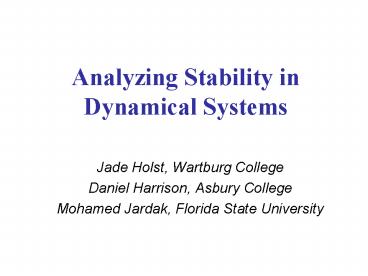Analyzing Stability in Dynamical Systems - PowerPoint PPT Presentation
Title:
Analyzing Stability in Dynamical Systems
Description:
Another commonly used method for analyzing stability of dynamical ... The logistic equation is a classic example of a potentially chaotic dynamical system. ... – PowerPoint PPT presentation
Number of Views:72
Avg rating:3.0/5.0
Title: Analyzing Stability in Dynamical Systems
1
Analyzing Stability in Dynamical Systems
- Jade Holst, Wartburg College
- Daniel Harrison, Asbury College
- Mohamed Jardak, Florida State University
2
One Dimensional Maps
The logistic equation is a classic example of a
potentially chaotic dynamical system. We have
Figure1 (top) demonstrates the chaotic nature of
the logistic system by plotting its asymptotic
solutions for a range of values of the parameter
r. This is called a bifurcation map .
Another commonly used method for analyzing
stability of dynamical systems in one or several
dimensions is the lyapunov exponent (Figure1
bottom.). These exponents measure the rate of
divergence of orbits originating from arbitrarily
close initial conditions. That is, they measure
a systems sensitivity to its initial conditions
(Note the correlation between the lyapunov
exponent and the bifurcation map). A positive
lyapunov exponent indicates that the system is
chaotic. The exponents are described as
n is the number of iteration of the dynamical
system and x0 is the initial condition.
Figure1
3
One Dimensional Maps (cont.)
As a stochastic counterpart, we used a variation
of the numerical approximation for the maximum
lyapunov exponent. Precisely, the derivative is
replaced by a difference quotient,
, where is a random
variable. Figure2 is a comparison of the means
obtained by using this counterpart and different
values of alpha.
Figure2
4
Higher Dimensional Maps
But How do we Analyze the Stability in Higher
Dimensions?
Lorenz Equations Initial
Conditions (-1.356, -2.492152, 12.31741) Parame
ters s 10, ? 28, ß 8/3 ?T .01
Figure 3
Solver Runge-Kutta (4,5) Built in solver in
Matlab
5
Higher Dimensional Maps (cont.)
Rossler Equations Initial
Conditions (-2.209787, 1353531, 0.070299) Param
eters a 0.2, b 0.2, c 5.7 ?T .01
Figure 4
Solver Runge-Kutta (4,5) Built in solver in
Matlab
6
Higher Dimensional Maps (cont.)
Van der Pol Initial Conditions
(0.1, 0.1, 0.1) Parameters b .01, c
1 ?T .01
Figure 5
Solver Runge-Kutta (4,5) Built in solver in
Matlab
7
Higher Dimensional Maps (cont.)
We look at One Dimension at a time!
8
Higher Dimensional Maps (cont.)
A poincare section is often used to reduce a
three dimensional (or higher) continuous system
to a descrete map of dimension one or two. The
strength behind this tool is that these sections
have the same topological properties as their
continuous counterparts. Often, the local maxima
of a variable are used as a one dimensional
poincare map (This is easily seen in Figure6.).
For more complicated systems, the distance
between the maxima is more descriptive of the
systems characteristics. Thus, bifurcation
diagrams that are similar to that of the logistic
equation can be generated by plotting points of
the section after many iterations of the
dynamical system (Figure7). Once again, this
procedure is applied to a range of values of a
given parameter. a. refers to the Rossler system,
b. to the Van der Pol, and c. to the Lorenz.
9
Higher Dimensional Maps (cont.)
These figures contain plots of the lyapunov
exponents (following the Y axis) for the three
systems in question. Note that the Van der Pol
lyapunov exponent does not correlate with
corresponding bifurcation map. This remains a
mystery for us.
10
Stochastic Initial Conditions
11
These graphics display the variance and mean
solutions to the Lorenz, Rossler, and Van der Pol
equations under the stochastic process described
previously, that is, using a Monte Carlo
Simulation.
12
Whats next?
Cell-to-cell mapping is another tool we are
researching. This method plots periodic orbits
that stay within a given surface. Thus, it
delineates the attractors in the surface. The
stochastic counterpart may involve replacing one
of the parameters with a stochastic process.































